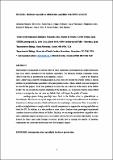Por favor, use este identificador para citar o enlazar a este item:
http://hdl.handle.net/10261/221282COMPARTIR / EXPORTAR:
 SHARE SHARE
 CORE
BASE CORE
BASE
|
|
| Visualizar otros formatos: MARC | Dublin Core | RDF | ORE | MODS | METS | DIDL | DATACITE | |

| Título: | The FixBox: hardware to provide on-orbit fixation capabilities to the EMCS on the ISS |
Autor: | Manzano, Aranzazu CSIC ORCID ; Creus, Eva; Tomás, Albert; Valbuena, Miguel A. CSIC ORCID; Villacampa, Alicia CSIC ORCID CVN; Ciska, Malgorzata CSIC ORCID ; Edelmann, Richard E.; Kiss, John Z.; Medina, F. Javier CSIC ORCID CVN ; Herranz, Raúl CSIC ORCID CVN | Palabras clave: | Microgravity Plant Spaceflight Hardware Preservation |
Fecha de publicación: | 6-oct-2020 | Editor: | Springer Nature | Citación: | Microgravity Science and Technology 32: 1105–1120 (2020) | Resumen: | Plant biology is an important area for the future of space exploration, but biological spaceflight experiments have been always constrained by the hardware capabilities. The European Modular Cultivation System (EMCS) unit was an incubator for small organisms, such as Arabidopsis thaliana, built by the European Space Agency (ESA) and was decommissioned in 2018. Here, we describe the FixBox system as add-on hardware to provide fixation capabilities to the plant growth cassettes, which, initially, were not designed to be used for that purpose. Tests were performed to ensure the successful use of this device in the EMCS facility. We also evaluate the required adaptations to the hardware, e.g., to guarantee that the reduced fluid motion in microgravity does not cause any bubbles that could impair the quality of fixation. Arabidopsis thaliana seedlings grown during spaceflight were fixed in the FixBox either in glutaraldehyde or formaldehyde. Electron microscopical images and confocal microscopy immunofluorescent localizations showed an excellent preservation of both cell ultrastructure and antigen conformation. Thus, it is possible to modify existing hardware to comply with the scientific requirements to augment the existing capabilities on board the ISS. In addition, it is also possible to reuse culture chambers from predesigned experimental containers into new modular subunits as FixBox. Similarly, we can design new hardware compatible with a novel cultivation chamber on board, such as is available in BIOLAB, to be used later with FixBox. Lessons learned for future space plant biology researchers include how to manage the number of hardware requirements and constraints on how to preserve the biological samples. | Descripción: | 30 p.-10 fig.-1 tab. | Versión del editor: | https://doi.org/10.1007/s12217-020-09837-5 | URI: | http://hdl.handle.net/10261/221282 | DOI: | 10.1007/s12217-020-09837-5 | ISSN: | 0938-0108 | E-ISSN: | 1875-0494 |
| Aparece en las colecciones: | (CIB) Artículos |
Ficheros en este ítem:
| Fichero | Descripción | Tamaño | Formato | |
|---|---|---|---|---|
| Microgravity Science and Technology_Manzano_2020.pdf | 4,81 MB | Adobe PDF |  Visualizar/Abrir |
CORE Recommender
SCOPUSTM
Citations
3
checked on 02-may-2024
WEB OF SCIENCETM
Citations
3
checked on 26-feb-2024
Page view(s)
188
checked on 07-may-2024
Download(s)
159
checked on 07-may-2024
Google ScholarTM
Check
Altmetric
Altmetric
NOTA: Los ítems de Digital.CSIC están protegidos por copyright, con todos los derechos reservados, a menos que se indique lo contrario.
